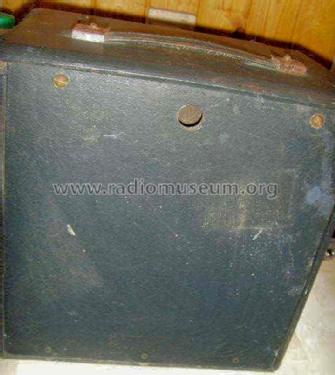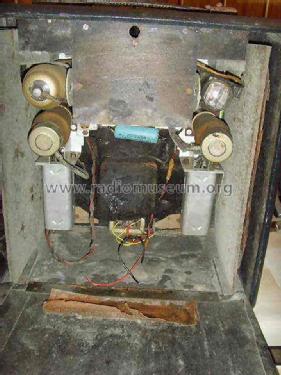New Baby Q All Dry cover
Pye Ltd., Radio Works; Cambridge
- Land
- Grossbritannien (UK)
- Hersteller / Marke
- Pye Ltd., Radio Works; Cambridge
- Jahr
- 1940
- Kategorie
- Rundfunkempfänger (Radio - oder Tuner nach WW2)
- Radiomuseum.org ID
- 78820
- Anzahl Röhren
- 4
- Hauptprinzip
- Superhet allgemein; ZF/IF 469 kHz
- Wellenbereiche
- Langwelle, Mittelwelle (LW+MW).
- Betriebsart / Volt
- Trockenbatterien / 1,5 & 90 Volt
- Lautsprecher
- Dynamischer LS, keine Erregerspule (permanentdynamisch)
- Material
- Leder / Stoff / Plastic / Segeltuch über div. Material
- von Radiomuseum.org
- Modell: New Baby Q All Dry [cover] - Pye Ltd., Radio Works;
- Form
- Reisegerät > 20 cm (netzunabhängig betreibbar)
- Abmessungen (BHT)
- 11.5 x 12 x 7.5 inch / 292 x 305 x 191 mm
- Bemerkung
-
The main visual difference btween the Baby Q Senior and New Baby Q All Dry is the cabinet style/colouring (single tone). The Trader 534 only lists later Mullard Octal for the Baby Q Senior though with US numbering (described as Mullard Amerty) and lists DK1 DF1 DAC1 DL2 for this New Baby Q. Before 1942 the Edge connect valves are unavailable. By 1946 Philips numbering used by Mullard: There are also some small component differences (listed by Trader 534 30th August 1941)
Generally from 1939 DK1 DF1 DAC1 DL2 but from late 1941 1A7G 1N5G 1H5G 1C5G, then in 1946:
DK32 replaces 1A7G
DF33 replaces 1N5G
DAC32 replaces 1H5G
DL35 replaces 1C5GThe edge (P8) and Octal valves/tubes are not base compatible but different production times and electrically similar. This occurs on many UK battery models between 1940 and 1945. Even in 1945 / 1946 the Edge connect types are unavailable and Mullard issues instructions on how to change the sockets from P8 Edge type to International octal and the list of Octal replacements. These changes are seen on Ever Ready, McMichael and others.
- Datenherkunft
- Radio! Radio!
- Literatur/Schema (1)
- Trader Service Sheet (suppl. of Wireless & El. Trader, etc.) (534)
- Autor
- Modellseite von Konrad Birkner † 12.08.2014 angelegt. Siehe bei "Änderungsvorschlag" für weitere Mitarbeit.
- Weitere Modelle
-
Hier finden Sie 628 Modelle, davon 484 mit Bildern und 342 mit Schaltbildern.
Alle gelisteten Radios usw. von Pye Ltd., Radio Works; Cambridge






